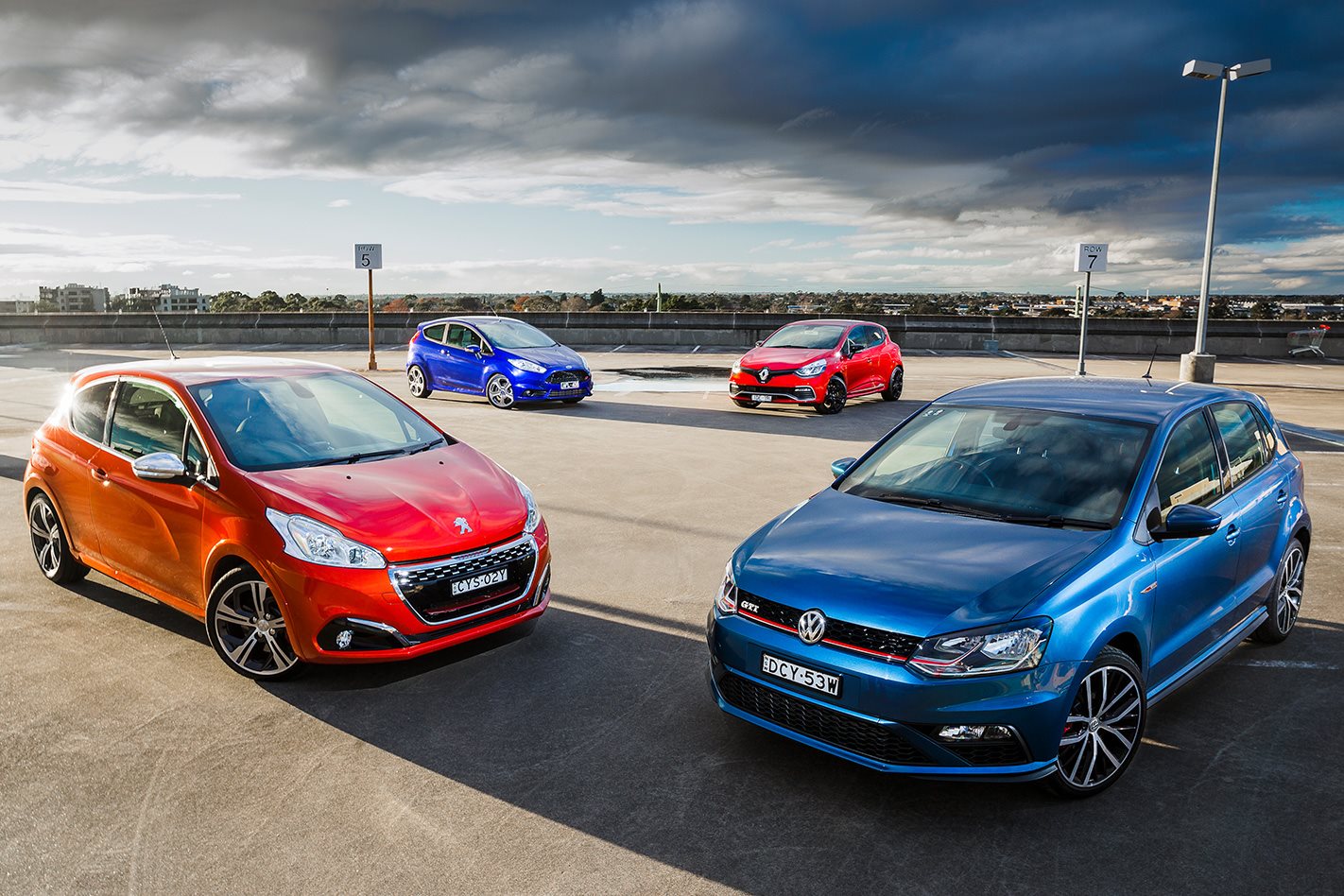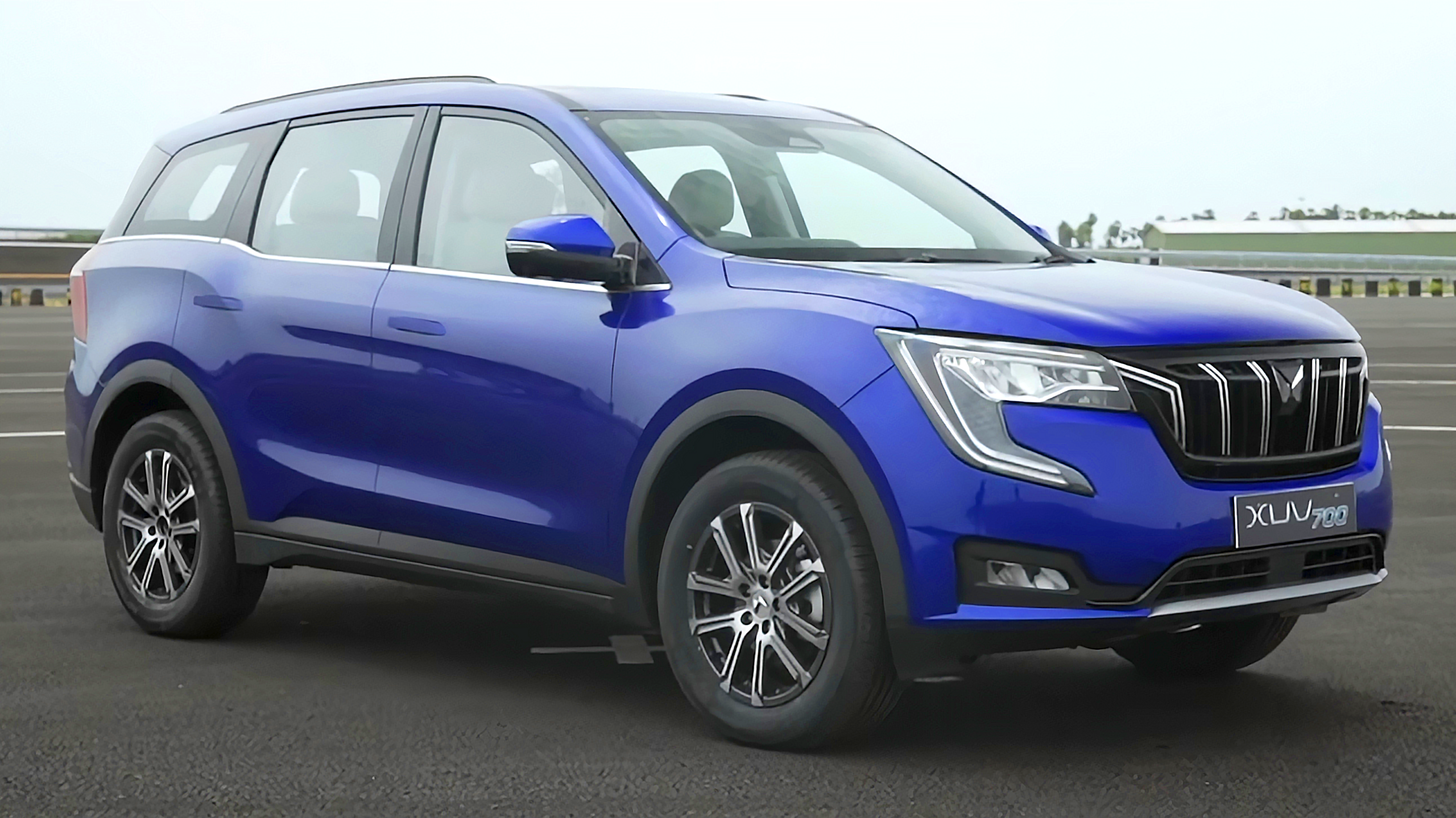You might not have considered a compact hot-hatch before.
You should. Not just because there’s a first time for everything, but because the biggest thing that strikes you when you see this lot lined up is just how much performance you get for the money these days.
Forget about the dinky-toy reputation; there’s nothing dinky about a small hatch these days. Fact is, they have as much, or more, front-seat space than, say, the first Aussie-made Camry of the 1980s that was sold – and accepted by the market – as a family car.
You can forget everything you thought you knew about performance in small hatchbacks. The facts can’t be ignored, every one of these alleged tiddlers would hose a GT Falcon of the 1970s across the first 400m of hotmix and, presumably, beyond. They’ll return remarkable fuel economy if you let them, they’re all well equipped, built to a high standard and are as practical as any other hatchback ever has been. And they’re cheap!
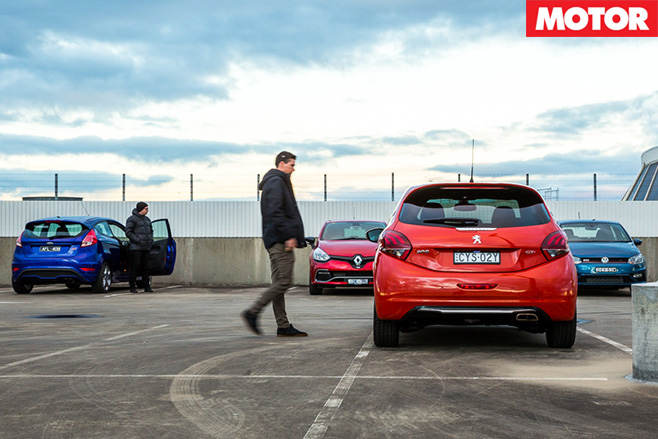
So what have we got here? Let’s start with the Renault Clio Sport. At $30,000 it’s the second most expensive car here. Mind you, it’s a four-door, so that’s where some of the extra gold goes, but it still looks like a two-door with those hidden rear door-handles. It’s also the only one here with a double-clutch transmission (a six-speed).
But we can’t let it off the hook completely, there’s no three-pedal option – it’s a double-clutch or nothing. With 1.6 litres and, like the rest of them, a turbo huffing away as well, the Renault is good for 147kW and 240Nm at a low 1750rpm.
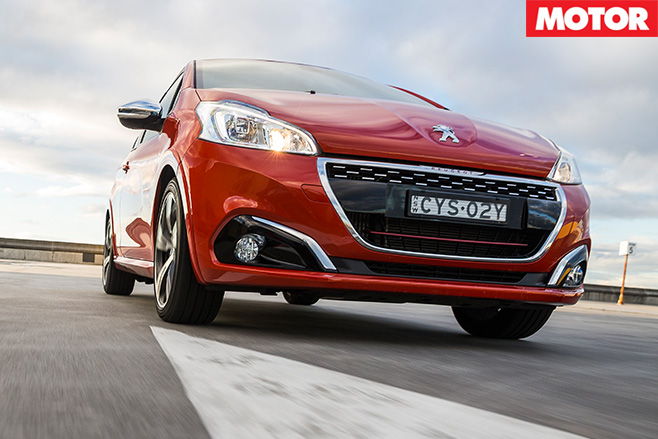
Last year, the VW Polo GTi ditched the twin-charged 1.4-litre engine and moved to a full 1.8 litres with a turbo. The result is 141kW and the most torque of this bunch: 320Nm. With the move to the bigger engine also came the option of a conventional six-speed manual tranny. At $27,490, it’s a neat $1500 more than the cheapest car here, the Fiesta ST. It’s also the retro king with that, um, eye-catching tartan interior.
Which leaves us with a car that has never failed to bring a twinkle to our eyes here at MOTOR: the remarkable Ford Fiesta ST. The price as we went to press was still $25,990, but it won’t be for long, so get in quick if you’re in the market. The 1.6-litre turbo is still good for 134kW and 240Nm, with 147kW and 290Nm available for bursts thanks to the overboost function – it’s still a crackerjack little engine.
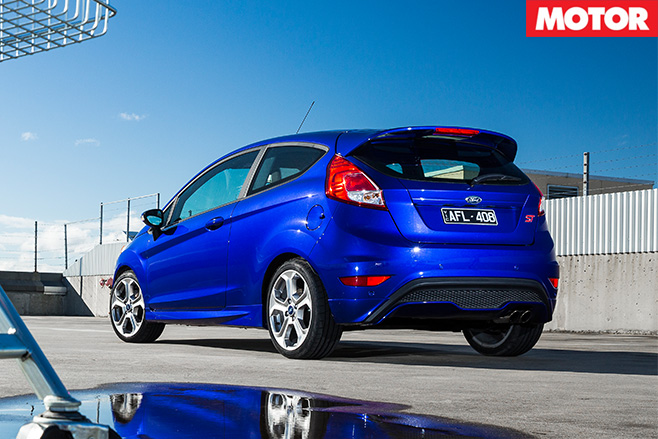
It wasn’t that the ST boosted up too quickly and lost traction, it just never really felt as strong at the top end and wringing it right out in each gear was harder work. The Clio crossed the line third with 7.1sec and 15.1sec at 151.6km/h with the Peugeot just ahead with 6.8sec and 15.0sec at 155.0km/h.
Which means the Polo GTi was the only one to break into the 14s; a 14.9sec at 155.3km/h, in fact, and a 6.8sec 0-100 time. What that doesn’t tell you is that the Polo feels torquier than the others and it’s only the VW’s tall second and third gearing that meant it didn’t go faster on the strip. It was only j-u-s-t getting into fourth gear at the 400m mark, so shorter cogs would see it well into the mid-14s we reckon.
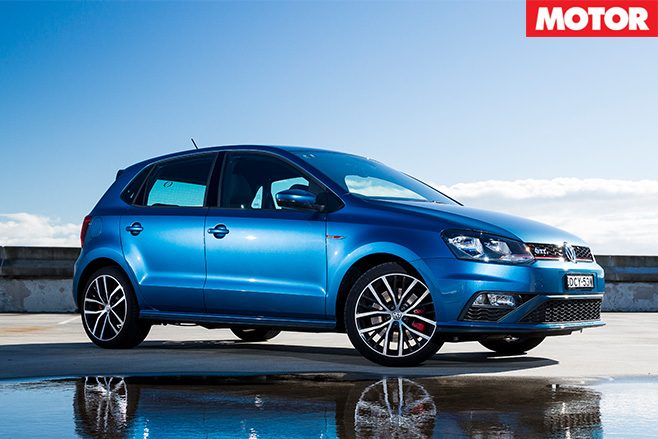
The Peugeot and Fiesta each gets a gust of wind up its skirt as you rev them up, giving that lovely turbo-motor impression of being blown along by a stiff tail-wind; which, if you think about how a turbocharger works, they are.
The Clio, meanwhile, is more or less in the same camp as the VW with a more linear delivery and a flatter torque curve overall. That’s also what makes the VW and the Renault feel the most grown-up of the four, with less of a teenager’s temperament and demeanour.
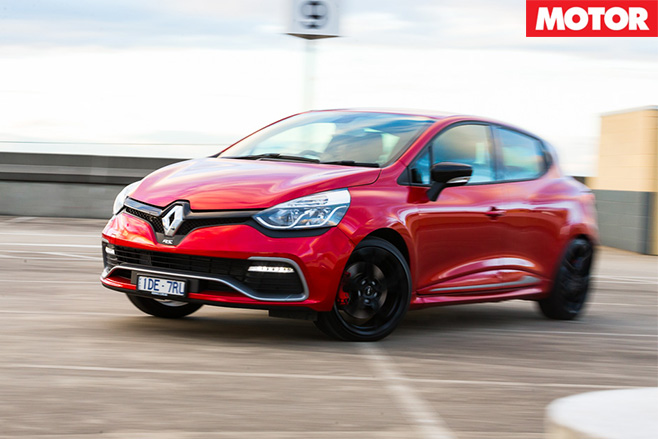
It’s worse when you back to back it with either the VW or the Peugeot because they both ride smoothly with loads of balance up their sleeves. It’s actually quite difficult to pick whether it was the Polo or the 208 that rides best; I reckoned it was the Pug, editor Campbell gave the nod to the VW. That suggests the difference is no more than the seat foam density in each because you’d make roughly two-and-a-half Campbells out of one me.
Either way, there’s more or less nothing between them, although the Polo does feel a bit more substantial in the way the body feels absolutely tight over the worst craters. One thing’s for sure, the Polo GTi has the best combination of steering weight, feel and accuracy. Though it’s not as twitchy as some, it never feels lazy or slow to turn.

If you’re into a sensitive – let’s call it slightly twitchy – chassis, then the Fiesta ST will be the one that does it for you. If you’re not that person, then the Ford then becomes the car most likely to cart you off if you lose concentration for a nano-second. Point of view, I believe they call it.
Little cars like these aren’t as lightweight as they used to be, but even so, there are no porkers among them, so they should stop pretty hard. Three of them do. The Clio pulled up from 100km/h in 36.1m, but it actually braked better on the second stop with a bit of heat in the rotors.
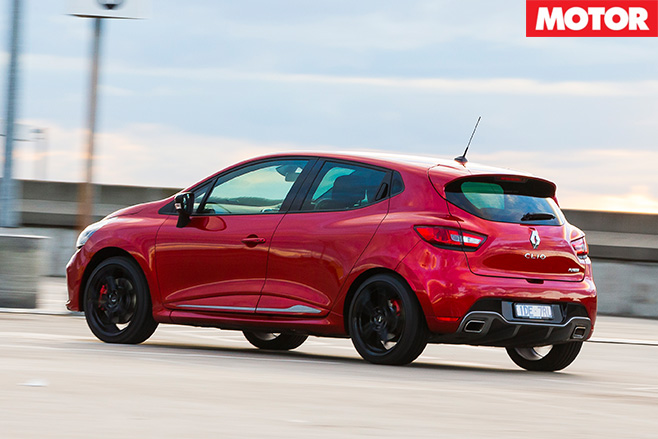
Which leaves us with the Peugeot which, as I write this, is still rolling to a stop from 100. Not only was its stopping distance disappointing with a best of 40.6 metres (and that on its second stop), but the pedal felt mushy and totally uninspiring. For what is such an otherwise dynamic package, this is odd to say the least.
When it comes to the peak-hour shuffle and the freeway-drone which, even though we don’t like to admit it, is where we do the bulk or our driving these days, the hatches shake themselves out in a different order again. Both French cars have tall top gears with the Peugeot reading 2300rpm at 100km/h and the Clio registering 2400rpm on its illegible-in-strong-sunlight tacho.
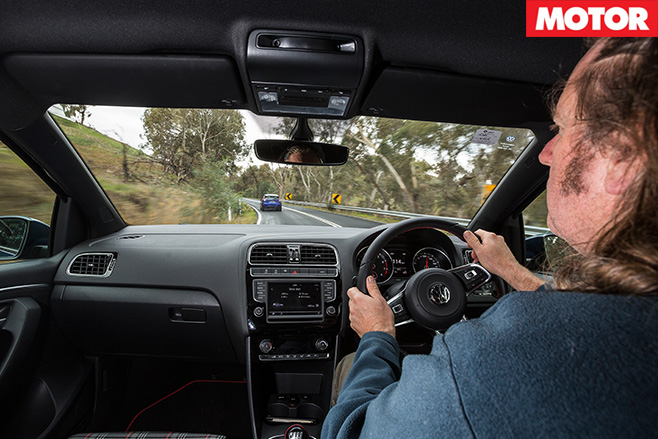
Volkswagen wins the slick-shifter award on your way to sixth gear, while the Fiesta has the rortiest engine note. The Clio’s shift paddles are a source of annoyances on a twisty run because they’re fixed to the steering column and don’t move with the wheel.
There are other things about the Clio’s interior that seem to exist purely to annoy you. The gear selector feels flimsy and brittle, while the ergonomics could only be French and include a cruise-control master switch between the centre-console that has to be disabled before the RS mode can be engaged. Sacre bleu! Merde!

Personally, I don’t find it too bad, because I’m long in the body and therefore sit high in a car. But Luffy, who is a good inch or two taller than me and possesses a more conventional torso:leg ratio, can’t read ’em. Fads come and go, but I really can’t see this one catching on.
By contrast, the Polo is so logical it’s almost boring. It has also been aped by plenty of other manufacturers over the years, so it’s starting to look a bit generic. But it works with heel-clicking efficiency and feels like a quality thing. The seats, tartan though they may be, are supportive and proportioned to suit a Germanic frame.

But you’ll forgive it because the standard Recaros are just lovely (even if you have to climb over the bolster to get out again) and the vision out is brilliant. In fact, the two three-doors (the Fiesta and 208) have by far the best view to the rear and side.
In the final wash-up, there’s a lot more to like about all these little hatches than there is to dislike. The first one to be eliminated from our short-list, however, would be the Clio. The double-clutch gearbox is less satisfying than it should be and it lacks that last little percentage of driver involvement. And those ergonomics prove that being different isn’t always better.

The top step of the podium comes down to the Peugeot and the VW. Ultimately, despite its terrific engine, refined feel and ultra-capable suspension, the Peugeot’s weedy brakes, loony dash layout and big price-tag play against it.
Leaving, of course, the all-but-flawless Polo GTI to claim the silverware. Which kind of sounds like it’s a default-winner by doing fewer things poorly, but that’s really not the case. The VW is capable, fast, well built, practical and a true bargain among bargains.
IN DETAIL
Peugeot 208 GTi

LIKE: Great ride/handling mix; plush interior DISLIKE: Weak brakes; confronting driving position; it’s expensive
SPECS Body: 3-door, 5-seat hatch Drive: front-wheel Engine: 1598cc inline-4, DOHC, 16v, turbo Bore/stroke: 77.0 x 85.8mm Compression: 10.5:1 Power: 153kW @ 6000rpm Torque: 300Nm @ 3000rpm 0-100km/h: 6.8sec (as tested) 0-400m: 15.0sec @ 155.0km/h (as tested) Power/weight: 131kW/tonne Transmission: 6-speed manual Weight: 1160kg Suspension(F): struts, coil springs, anti-roll bar Suspension(R): torsion beam, coil springs, anti-roll bar L/W/H: 3973/1739/1460mm Wheelbase: 2538mm Tracks: 1482/1492mm (f/r) Steering: electrically-assisted rack-and-pinion Brakes(F): 302mm ventilated discs, single-piston calipers Brakes(R): 249mm solid discs, single-piston calipers Wheels: 17.0 x 7.5-inch (f/r) Tyre sizes: 205/45 R17 (f/r) Tyre: Michelin Pilot Exalto Price as tested: $30,990
VW Polo GTI
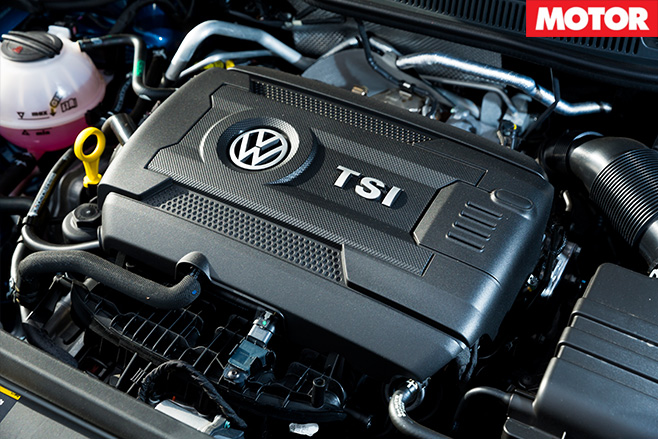
LIKE: Grunty engine; slick-shifting box; decent ride DISLIKE: Interior feels its age; torque can overwhelm traction
SPECS Body: 5-door, 5-seat hatch Drive: front-wheel Engine: 1798cc inline-4, DOHC, 16v, turbo Bore/stroke: 82.5 x 84.2mm Compression: 9.6:1 Power: 141kW @ 4300-6200rpm Torque: 320Nm @ 1450-4200rpm 0-100km/h: 6.8sec (as tested) 0-400m: 14.9sec @ 155.3km/h (as tested) Power/weight: 114kW/tonne Transmission: 6-speed manual Weight: 1234kg Suspension(F): struts, A-arms, coil springs, anti-roll bar Suspension(R): torsion beam, coil springs, anti-roll bar L/W/H: 3983/1682/1443mm Wheelbase: 2470mm Tracks: 1447/1441mm (f/r) Steering: electrically-assisted rack-and-pinion Brakes(F): 288mm ventilated discs, single-piston calipers Brakes(R): 260mm solid discs, single-piston calipers Wheels: 17 x 7.5-inch (f/r) Tyre sizes: 205/40 R17 (f/r) Tyre: Bridgestone Potenza S001 Price as tested: $27,490
Ford Fiesta ST

LIKE: Awesome chassis; value; Recaro seats DISLIKE: Will bite if provoked; ride can be firm
SPECS Body: 3-door, 5-seat hatch Drive: front-wheel Engine: 1596cc inline-4, DOHC, 16v, turbo Bore/stroke: 79.0 x 81.4mm Compression: 10.1:1 Power: 134kW @ 5700rpm (147kW on overboost) Torque: 240Nm @ 1600-5000rpm (290Nm on overboost) 0-100km/h: 7.5sec (as tested) 0-400m: 15.3sec @ 152.7km/h (as tested) Power/weight: 112kW/tonne Transmission: 6-speed manual Weight: 1197kg Suspension(F): struts, coil springs, anti-roll bar Suspension(R): torsion beam, coil springs, anti-roll bar L/W/H: 3982/1978/1456mm Wheelbase: 2489mm Tracks: 1492/1481mm (f/r) Steering: electrically-assisted rack-and-pinion Brakes(F): 278mm ventilated discs, 2-piston calipers Brakes(R): 253mm solid discs, single-piston calipers Wheels: 17 x 7.0-inch (f/r) Tyre sizes: 205/40 R17 84Y (f/r) Tyre: Bridgestone Potenza RE050A Price as tested: $25,990
Renault Clio RS
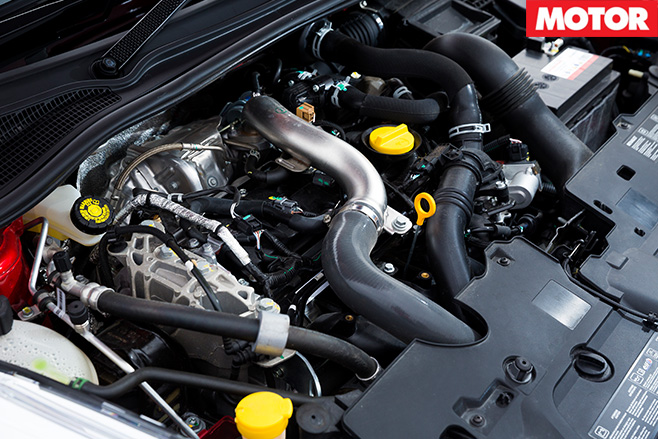
LIKE: Strong brakes; five-door practicality DISLIKE: Lacklustre transmission; jittery back-road ride
SPECS Body: 5-door, 5-seat hatch Drive: front-wheel Engine: 1618cc inline-4, DOHC, 16v, turbo Bore/stroke: 79.7 x 81.1mm Compression: 9.5:1 Power: 147kW @ 6000rpm Torque: 240Nm @ 1750rpm 0-100km/h: 7.1sec (as tested) 0-400M: 15.1sec @ 151.6km/h (as tested) Power/weight: 120kW/tonne Transmission: 6-speed dual-clutch Weight: 1218kg Suspension(F): struts, coil-springs, anti-roll bar Suspension(R): torsion beam, coil springs, anti-roll bar L/W/H: 4090/1732/1432mm Wheelbase: 2589mm Tracks: 1504/1500mm Steering: electrically-assisted rack-and-pinion Brakes(F): 320mm ventilated discs, single-piston calipers Brakes(R): 260mm solid discs, single-piston calipers Wheels: 17.0 x 7.5-inch (f/r) Tyre sizes: 205/45 R17 (f/r) Tyres: Goodyear Eagle F1 Asymmetric 2 Price as tested: $29,990

